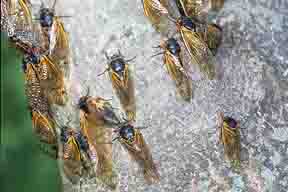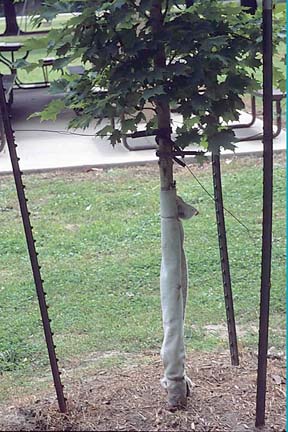Periodical Cicada�� | |
|---|---|
| May 29, 2007 | |
|
We are receiving reports of periodical cicadas emerging in northern Illinois during the week of May 20. Detailed reports are of hundreds of nymphal exuviae (skins) and wings on the ground in scattered locations. These early-emerging cicadas, even though there may be hundreds, are easy prey for birds and other predators, accounting for the detached wings being found. We expect full emergence to occur over the observed Memorial Day Weekend, so they should be out by the time this issue is received during the last week of May. This northern Illinois periodical cicada brood emergence will be north of a line from the junction of Iroquois and Kankakee counties on the eastern edge of Illinois southwest to north Sangamon County and northwest to the Rock Island area. The emergence extends into eastern Iowa and north into Wisconsin to a line extending east from the north edge of Iowa.  Both sexes of cicadas will be present for 2 to 3 weeks, with the males dying by mid-June. Only the males sing, so that will stop by that time. While the males are singing is a good time to check your clientele areas to determine whether small trees need to be protected. Periodical cicadas expand their range by only about one-half mile at each emergence; and egg-laying is heavier where the cicadas are more numerous, that is, where the male singing is louder. Based on previous experience, egg-laying will be heavy within 1/8 mile of heavy infestations and dwindle to almost nothing 1/2 mile away. Although a few eggs will be laid before the males die, most egg-laying occurs from mid-June through mid- to late July. As a result, while the males are singing is the best time to protect young trees from egg-laying damage. The female cicadas use ovipositors (egg-laying devices) to slit twigs and insert eggs. Most attacked twigs are about 1/4 inch (pencil-sized) in diameter, but eggs can be laid in branches up to about 2-1/2 inches in diameter. This egg-laying damage weakens the stems, making them susceptible to breaking by high winds. Broken branches will be replaced by new branches, but broken trunks will not. Broken stems of shrubs will be replaced by the root system.  Protect trunks of young trees with cheesecloth, shade cloth, nylon screening, or other flexible mesh that keeps the female cicadas from laying eggs. This protection should extend from the soil line to the first branches. Tie it at the top and bottom to keep cicadas from getting under the mesh. Ties along the trunk may also be needed if there are openings where cicadas could enter. Insecticide application is not recommended. Although pyrethroid and other insecticides kill large numbers of periodical cicadas, research has shown that they have little effect on the amount of egg-laying and subsequent tree damage. (Phil Nixon and James Schuster)�� | |
| Author: | Phil Nixon |
